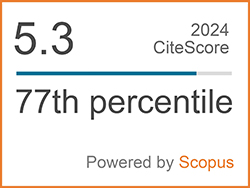Synthesis and Characterization of Nano Active Filler of Pumice Particle Produced by Sol-Gel Process with Different Precipitation Temperatures for Enhancing the Impact Properties of GFRP Composite
Abstract
Keywords
[1] I. Pratomo, “Klasifikasi gunung api aktif Indonesia, studi kasus dari beberapa letusan gunung api dalam sejarah,” Indonesian Journal on Geoscience, vol. 1, no. 4, pp. 209–227, Dec. 2006, doi: 10.17014/ijog.1.4.209-227.
[2] O. Ilter, “Use of pumice in mortar and rendering for lightweight building block,” M.S. thesis, Department of Civil Engineering, Eastern Mediterranean University, 2010.
[3] A. Mourhly, M. Khachani, A. El Hamidi, M. Kacimi, M. Halim, and S. Arsalane, “The synthesis and characterization of low-cost mesoporous silica SiO2 from local pumice rock,” Nanomaterials and Nanotechnology, vol. 5, 2015, doi: 10.5772/62033.
[4] S. Muljani, R. Dewati, Suprihatin, K. Sumada, R. Dewati, Suprihatin, and K. Sumada, “Precipitated silica by precipitation process of the sodium silicate solution with carbon dioxide gas (CO2) on fixed bed column,” in Nusantara Science and Technology Proceedings, Galaxy Science, Apr. 2019, pp. 231–236. doi: 10.11594/ nstp.2019.0230.
[5] I. J. Fernandes, D. Calheiro, F. A. L. Sánchez, A. L. D. Camacho, T. L. A. de C. Rocha, C. A. M. Moraes, and V. C. de Sousa, “Characterization of silica produced from rice husk ash: Comparison of purification and processing methods,” Materials Research, vol. 20, no. suppl 2, pp. 512–518, Oct. 2017, doi: 10.1590/1980-5373-mr-2016-1043.
[6] M. Palaniappan, S. Palanisamy, T. M. Murugesan, N. H. Alrasheedi, S. Ataya, S. Tadepalli, and A. A. Elfar, “Novel ficus retusa l. aerial root fiber: A sustainable alternative for synthetic fibres in polymer composites reinforcement,” Biomass Conversion and Biorefinery, vol. 15, no. 5, pp. 7585–7601, Mar. 2025, doi: 10.1007/s13399-024-05495-4.
[7] H. Li, B. Cheng, W. Gao, C. Feng, C. Huang, Y. Liu, P. Lu, and H. Zhao, “Recent research progress and advanced applications of silica/polymer nanocomposites,” Nanotechnology Reviews, vol. 11, no. 1, pp. 2928–2964, 2022, doi: 10.1515/ntrev-2022-0484.
[8] A. Jumahat, C. Soutis, S. A. Abdullah, and S. Kasolang, “Tensile properties of nanosilica/epoxy nanocomposites,” Procedia Engineering, vol. 41, no. Iris, pp. 1634–1640, 2012, doi: 10.1016/j.proeng.2012.07.361.
[9] C. M. Manjunatha, A. C. Taylor, A. J. Kinloch, and S. Sprenger, “The tensile fatigue behaviour of a silica nanoparticle-modified glass fibre reinforced epoxy composite,” Composites Science and Technology, vol. 70, no. 1, pp. 193–199, 2010, doi: 10.1016/j.compscitech.2009.10.012.
[10] Y. Gitiara, R. Barbaz-isfahani, S. Saber-samandari, and M. Sadighi, “Effect of nanoparticles on the improving mechanical behavior of GFRP composites in a corrosive environment,” Journal of Nanoanalysis, vol. 9, no. 1, pp. 68–82, 2022, doi: 10.22034/jna.2021. 1930895.1256.
[11] G. Tsintskaladze, T. Kordzakhia, R. Skhvitaridze, T. Sharashenidze, M. Zautashvili, and G. Beridze, “Physical and chemical characteristics of pumice from some regions of georgia and the prospects for its use in lightweight concrete with environmental advantages,” in Environmental Technology and Sustainability. New York: Apple Academic Press, pp. 247–256, 2024. doi: 10.1201/ 9781003397960-16.
[12] S. Kamarian, A. Khalvandi, Tran, T. M. Nguyen, Barbaz-Isfahani, Reza, S. Saber-Samandari, and J.-I. Song, “Predicting ESP and HNT effects on the mechanical properties of eco-friendly composites subjected to micro-indentation test,” Advances in Nano Research, vol. 15, no. 4, pp. 315–328, 2023, doi: 10.12989/anr.2023.15.4.315.
[13] A. Rakhman, K. Diharjo, W. W. Raharjo, V. Suryanti, and S. Kaleg, “Improvement of fire resistance and mechanical properties of glass fiber reinforced plastic (GFRP) composite prepared from combination of active nano filler of modified pumice and commercial active fillers,” Polymers, vol. 15, no. 1, 2023, doi: 10.3390/polym15010051.
[14] S. A. O. Adeyeye and T. J. Ashaolu, “Applications of nano-materials in food packaging: A review,” Journal of Food Process Engineering, vol. 44, no. 7, pp. 1–8, 2021, doi: 10.1111/jfpe.13708.
[15] R. Barbaz-Isfahani, A. Khalvandi, T. Mai Nguyen Tran, S. Kamarian, S. Saber-Samandari, and J. Song, “Synergistic effects of egg shell powder and halloysite clay nanotubes on the thermal and mechanical properties of abacá/polypropylene composites,” Industrial Crops and Products, vol. 205, no. May, p. 117498, Dec. 2023, doi: 10.1016/j.indcrop.2023. 117498.
[16] S. O. Okuma, M. Obaseki, D. O. Ofuyekpone, and O. E. Ashibudike, “A review assessment of fiber-reinforced polymers for maritime applications,” Journal of Advanced Industrial Technology and Application, vol. 4, no. 1, pp. 17–28, 2023, doi: 10.30880/jaita.2023.04.01.003.
[17] A. D. Akinwekomi, I. O. Oladele, L. N. Onuh, E. E. Essien, N. I. Agbeboh, and M. O. Idris, “Development and characterization of hybrid particulate-fiber reinforced epoxy composites,” Applied Science and Engineering Progress, vol. 17, no. 4, 2024, Art. no. 7391, doi: 10.14416/ j.asep.2024.06.001.
[18] S. Alimirzaei, R. Barbaz-isfahani, A. Khodaei, and M. Ahmadi, “Investigating the flexural behavior of nanomodified multi-delaminated composites using acoustic emission technique,” Ultrasonics, vol. 138, 2024, Art. no. 107249, doi: 10.1016/j.ultras.2024.107249.
[19] F. Rahmani, R. Barbaz-Isfahani, S. Saber-Samandari, and M. Salehi, “Experimental and analytical investigation on forced and free vibration of sandwich structures with reinforced composite faces in an acidic environment,” Heliyon, vol. 9, no. 10, Oct. 2023, Art. no. e20864, doi: 10.1016/j.heliyon.2023.e20864.
[20] M. A. Rida, and, and F. Harb, “Synthesis and characterization of amorphous silica nanoparitcles from aqueous silicates uisng cationic surfactants,” Journal of Metals, Materials and Minerals, vol. 24, no. 1, pp. 37–42, 2014, doi: 10.14456/jmmm.2014.7.
[21] P. Chindaprasirt and U. Rattanasak, “Eco-production of silica from sugarcane bagasse ash for use as a photochromic pigment filler,” Scientific Reports, vol. 10, no. 1, p. 9890, Jun. 2020, doi: 10.1038/s41598-020-66885-y.
[22] P. S. Utama, R. Yamsaengsung, and C. Sangwichien, “Production and characterization of precipitated silica from palm oil mill fly ash using CO2 impregnation and mechanical fragmentation,” Brazilian Journal of Chemical Engineering, vol. 36, no. 1, pp. 523–530, 2019, doi: 10.1590/0104-6632.20190361s20170458.
[23] Y. Zhang, Z. Zeng, H. Qi, X. Yin, H. Li, X. Wang, and S. Chen, “Two-stage influences of hydrothermal fluids on pumice near the Iheya North hydrothermal field, Okinawa Trough,” Marine Georesources & Geotechnology, vol. 36, no. 4, pp. 393–404, May 2018, doi: 10.1080/1064119X.2017.1318987.
[24] M. W. Syabani, I. Amaliyana, I. Hermiyati, and Y. I. Supriyatna, “Silica from geothermal waste as reinforcing filler in artificial leather,” Key Engineering Materials, vol. 849, pp. 78–83, Jun. 2020, doi: 10.4028/www.scientific.net/KEM.849.78.
[25] N. Pal, J.-H. Lee, and E.-B. Cho, “Recent trends in morphology-controlled synthesis and application of mesoporous silica nanoparticles,” Nanomaterials, vol. 10, no. 11, p. 2122, Oct. 2020, doi: 10.3390/nano10112122.
[26] R. Narayan, U. Nayak, A. Raichur, and S. Garg, “Mesoporous silica nanoparticles: A comprehensive review on synthesis and recent advances,” Pharmaceutics, vol. 10, no. 118, pp. 1–49, Aug. 2018, doi: 10.3390/pharmaceutics 10030118.
[27] I. J. Fernandes, C. A. M. Moraes, J. R. J. Egea, and V. C. Sousa, “Production and characterization of silica materials from rice husk ash by different combustion processes,” Powder Technology, vol. 436, 2024, doi: 10.1016/j.powtec.2024.119473.
[28] B. Xue, X. Wang, L. Yu, B. Di, Z. Chen, Y. Zhu, and X. Liu, “Self-assembled lignin-silica hybrid material derived from rice husks as the sustainable reinforcing fillers for natural rubber,” International Journal of Biological Macromolecules, vol. 145, pp. 410–416, Feb. 2020, doi: 10.1016/j.ijbiomac.2019.12.182.
[29] S. S. Pole and A. I. Isayev, “The nonlinear stress relaxation behavior after a step shear of star‐shaped styrene‐butadiene rubber filled with precipitated silica: Experiment and simulation,” Journal of Applied Polymer Science, vol. 138, no. 12, Mar. 2021, doi: 10.1002/app.50080.
[30] J. A. Santana Costa and C. M. Paranhos, “Systematic evaluation of amorphous silica production from rice husk ashes,” Journal of Cleaner Production, vol. 192, pp. 688–697, Aug. 2018, doi: 10.1016/j.jclepro.2018.05.028.
[31] L. N. A. Tuan, L. T. K. Dung, L. D. T. Ha, N. Q. Hien, D. V. Phu, and B. D. Du, “Preparation and characterization of nanosilica from rice husk ash by chemical treatment combined with calcination,” Vietnam Journal of Chemistry, vol. 55, no. 4, Sep. 2017, doi: 10.15625/2525-2321. 2017-00490.
[32] P. E. Imoisili, K. O. Ukoba, and T.-C. Jen, “Green technology extraction and characterisation of silica nanoparticles from palm kernel shell ash via sol–gel,” Journal of Materials Research and Technology, vol. 9, no. 1, pp. 307–313, Jan. 2020, doi: 10.1016/j.jmrt. 2019.10.059.
[33] M. Zainudin, K. Diharjo, M. Kaavessina, and D. Setyanto, “The properties degradation of exposed GFRP roof,” AIP Conference Proceedings, vol. 1931, pp. 1–8, 2018, doi: 10.1063/1.5024122.
[34] B. Mylsamy, S. K. M. Shanmugam, K. Aruchamy, S. Palanisamy, R. Nagarajan, and N. Ayrilmis, “A review on natural fiber composites: polymer matrices, fiber surface treatments, fabrication methods, properties, and applications,” Polymer Engineering and Science Science, vol. 64, no. 6, pp. 2345–2373, Jun. 2024, doi: 10.1002/pen.26713.
[35] T. P. Sathishkumar, P. Navaneethakrishnan, and P. Maheskumar, “Thermal stability and tribological behaviors of tri-fillers reinforced epoxy hybrid composites,” Applied Science and Engineering Progress, vol. 14, no. 4, pp. 727–737, 2021, doi: 10.14416/j.asep.2021.08.002.
[36] K. Diharjo, F. Gapsari, A. Andoko, M. N. Wijaya, S. Mavinkere Rangappa, and S. Siengchin, “Flammability and thermal resistance of ceiba petandra fiber-reinforced composite with snail powder filler,” Polymer Composites, vol. 45, no. 6, pp. 1–14, 2024, doi: 10.1002/pc. 28100.
[37] S. Alraddadi, “The finite size effect on the surface structure and thermal properties of nanostructured natural pumice,” Advances in Materials and Processing Technologies, pp. 1–13, Mar. 2023, doi: 10.1080/2374068X.2023. 2189673.
[38] D. Bokov, A. T. Jalil, S. Chupradit, W. Suksatan, M. J. Ansari, I. H. Shewael, G. H. Valiev, and E. Kianfar, “Nanomaterial by sol‐gel method: synthesis and application,” Advances in Materials Science and Engineering, vol. 2021, no. 1, Jan. 2021, doi: 10.1155/2021/5102014.
[39] Ł. Klapiszewski, M. Królak, and T. Jesionowski, “Silica synthesis by the sol-gel method and its use in the preparation of multifunctional biocomposites,” Central European Journal of Chemistry, vol. 12, no. 2, pp. 173–184, 2014, doi: 10.2478/s11532-013-0370-9.
[40] L. P. Singh, S. K. Bhattacharyya, R. Kumar, G. Mishra, U. Sharma, G. Singh, and S. Ahalawat, “Sol-gel processing of silica nanoparticles and their applications,” Advances in Colloid and Interface Science, vol. 214, pp. 17–37, 2014, doi: 10.1016/j.cis.2014.10.007.
[41] F. Saputra, A. Fadli, and A. Amri, “Kinetika reaksi pada sintesis hidroksiapatit dengan metode presipitasi,” Jurnal Online Mahasiswa Fakultas Teknik Universitas Riau, vol. 3, no. 1, pp. 1–6, 2016.
[42] U. Zulfiqar, T. Subhani, and S. Wilayat Husain, “Towards tunable size of silica particles from rice husk,” Journal of Non-Crystalline Solids, vol. 429, pp. 61–69, 2015, doi: 10.1016/ j.jnoncrysol.2015.08.037.
[43] T. D. Hapuarachchi and T. Peijs, “Aluminium trihydroxide in combination with ammonium polyphosphate as flame retardants for unsaturated polyester resin,” Express Polymer Letters, vol. 3, no. 11, pp. 743–751, 2009, doi: 10.3144/expresspolymlett.2009.92.
[44] K. Diharjo, N. S. Suharty, A. E. B. Nusantara, and R. Afandi, “The effect of sokka clay on the tensile and burning properties of rPP/clay composite,” Advanced Materials Research, vol. 1123, pp. 338–342, 2015, doi: 10.4028/ www.scientific.net/amr.1123.338.
[45] Standard test method for determining the izod impact strength of plastics, ASTM D5941-96, 1996.
[46] X. Cai, R. Y. Hong, L. S. Wang, X. Y. Wang, H. Z. Li, Y. Zheng, and D. G. Wei, “Synthesis of silica powders by pressured carbonation,” Chemical Engineering Journal, vol. 151, no. 1–3, pp. 380–386, 2009, doi: 10.1016/j.cej.2009.03.060.
[47] J. Lee, T. Lee, K. Kim, B. Kim, G. Kwag, J. Kim, S. Ji, W. Kim, and H. Paik, “Poly(styrene‐ r ‐butadiene)‐ b ‐poly(poly(ethylene glycol) methyl ether methacrylate) as a silica dispersant in rubber compounds,” Polymer International, vol. 63, no. 5, pp. 908–914, May 2014, doi: 10.1002/ pi.4644.
[48] Z. Zhang, A. E. Berns, S. Willbold, and J. Buitenhuis, “Synthesis of poly(ethylene glycol) (PEG)-grafted colloidal silica particles with improved stability in aqueous solvents,” Journal of Colloid and Interface Science, vol. 310, no. 2, pp. 446–455, Jun. 2007, doi: 10.1016/j.jcis.2007. 02.024.
[49] K. Suzuki, K. Ikari, and H. Imai, “Synthesis of silica nanoparticles having a well-ordered mesostructure using a double surfactant system,” Journal of the American Chemical Society, vol. 126, no. 2, pp. 462–463, Jan. 2004, doi: 10.1021/ ja038250d.
[50] A. Mourhly, F. Jhilal, A. E. Hamidi, M. Halim, and S. Arsalane, “Highly efficient production of mesoporous nano-silica from unconventional resource: Process optimization using a central composite design,” Microchemical Journal, vol. 145, pp. 139–145, 2019, doi: 10.1016/j.microc. 2018.10.030.
[51] A. F. Lourenço, J. A. F. Gamelas, and P. J. Ferreira, “Increase of the filler content in papermaking by using a silica-coated PCC filler,” Nordic Pulp and Paper Research Journal, vol. 29, no. 2, pp. 240–245, May 2014, doi: 10.3183/npprj-2014-29-02-p240-245.
[52] B. Kurc, “Precipitated silica as filler for polymer electrolyte based on poly(acrylonitrile)/ sulfolane,” Journal of Solid State Electrochemistry, vol. 18, no. 7, pp. 2035–2046, Jul. 2014, doi: 10.1007/s10008-014-2451-x.
[53] L. Zu, X. Cui, Y. Jiang, Z. Hu, H. Lian, Y. Liu, Y. Jin, Y. Li, and X. Wang, “Preparation and electrochemical characterization of mesoporous polyaniline-silica nanocomposites as an electrode material for pseudocapacitors,” Materials, vol. 8, no. 4, pp. 1369–1383, Mar. 2015, doi: 10.3390/ma8041369.
[54] E. C. Peres, J. C. Slaviero, A. M. Cunha, A. Hosseini-Bandegharaei, and G. L. Dotto, “Microwave synthesis of silica nanoparticles and its application for methylene blue adsorption,” Journal of Environmental Chemical Engineering, vol. 6, no. 1, pp. 649–659, 2018, doi: 10.1016/j.jece.2017.12.062.
[55] C. J. G. V. D. Grift, P. A. Elberse, A. Mulder, and J. W. Geus, “Preparation of silica-supported copper catalysts by means of deposition-precipitation,” Applied Catalysis, vol. 59, no. 1, pp. 275–289, Mar. 1990, doi: 10.1016/S0166-9834(00)82204-6.
[56] A. Lazaro, Y. X. Chen, C. Verhoeven, and Y. Hendrix, “One-step synthesis of ordered mesoporous silica from olivine and its pore size tailoring,” Journal of Cleaner Production, vol. 238, Nov. 2019, Art. no. 117951, doi: 10.1016/ j.jclepro.2019.117951.
[57] K. Aruchamy, M. Karuppusamy, S. Krishnakumar, S. Palanisamy, M. Jayamani, K. Sureshkumar, S. K. Ali, and S. A. Al-Farraj, “Enhancement of mechanical properties of hybrid polymer composites using palmyra palm and coconut sheath fibers: The role of tamarind shell powder,” BioResources, vol. 20, no. 1, pp. 698–724, Nov. 2024, doi: 10.15376/biores.20.1.698-724.
[58] T. Raja and Y. Devarajan, “Study on the mechanical and thermal properties of basalt fiber-reinforced lead oxide nanoparticle polymer composite for advanced energy storage applications,” Journal of Energy Storage, vol. 108, Feb. 2025, Art. no. 115079, doi: 10.1016/ j.est.2024.115079.
[59] D. A. Durressa, E. G. Koricho, A. N. Ali, and G. A. Kebede, “Characterization and modeling of residual elastic properties of impact damaged glass fiber composite,” Results in Engineering, vol. 25, p. 103721, Mar. 2025, doi: 10.1016/ j.rineng.2024.103721.
[60] R. Ramasubbu, A. Kayambu, S. Palanisamy, and N. Ayrilmis, “Mechanical properties of epoxy composites reinforced with Areca catechu fibers containing silicon carbide,” BioResources, vol. 19, no. 2, pp. 2353–2370, Feb. 2024, doi: 10.15376/biores.19.2.2353-2370.
[61] T. Wibawa, K. Diharjo, D. Ariawan, W. W. Raharjo, C. H. Wibowo, F. N. Saputro, A. Rakhman, A. Muharam, S. Kaleg, A. Hapid, and M. Zulkefly, “Enhancing the mechanical and fire-resistant properties of GFRP composite using boric acid and sodium silicate fillers,” Engineering, Technology and Applied Science Research, vol. 14, no. 6, pp. 18911–18922, 2024, doi: 10.48084/etasr.9271.
[62] K. Sravanthi, V. Mahesh, and B. Nageswara Rao, “Influence of micro and nano carbon fillers on impact behavior of GFRP composite materials,” Materials Today: Proceedings, vol. 37, pp. 1075–1078, 2021, doi: 10.1016/j.matpr. 2020.06.298.
[63] S. Y. Fu, X. Q. Feng, B. Lauke, and Y. W. Mai, “Effects of particle size, particle/matrix interface adhesion and particle loading on mechanical properties of particulate-polymer composites,” Composites Part B: Engineering, vol. 39, no. 6, pp. 933–961, 2008, doi: 10.1016/j.compositesb. 2008.01.002.
[64] I. Erunkulu, G. Malumbela, and O. P. Oladijo, “Geopolymer synthesis and alkaline activation technique of fly ash and slag source material: a review,” Applied Science and Engineering Progress, vol. 16, no. 3, Jan. 2022, Art. no. 6600, doi: 10.14416/j.asep.2023.01.005.
[65] T. Nanda, K. Singh, D. Shelly, and R. Mehta, “Advancements in multi-scale filler reinforced epoxy nanocomposites for improved impact strength: a review,” Critical Reviews in Solid State and Materials Sciences, vol. 46, no. 4, pp. 281–329, 2021, doi: DOI: 10.1080/10408436. 2020.1777934.
[66] N. S. Suharty, H. Ismail, K. Dihardjo, M. Nizam, and M. Firdaus, “Improvement of inflammability and biodegradability of bio-composites using recycled polypropylene with kenaf fiber containing mixture fire retardant,” Advanced Materials Research, vol. 950, pp. 18–23, Jun. 2014, doi: 10.4028/www.scientific.net/AMR.950.18.
[67] A. Kar, D. Saikia, S. Palanisamy, and N. Pandiarajan, “Effect of fiber loading on the mechanical, morphological, and dynamic mechanical characteristics of calamus tenuis fiber reinforced epoxy composites,” Journal of Vinyl and Additive Technology, vol. 31, no.1, pp. 1–17, 2024, doi: 10.1002/vnl.22167.
[68] S. Kaleg, D. Ariawan, and K. Diharjo, “The flexural strength of glass fiber reinforced polyester filled with aluminum tri-hydroxide and montmorillonite,” Key Engineering Materials, vol. 772, pp. 28–32, 2018, doi: 10.4028/www. scientific.net/KEM.772.28.
[69] F. A. dos Santos, G. C. V. Iulianelli, and M. I. B. Tavares, “The use of cellulose nanofillers in obtaining polymer nanocomposites: Properties, processing, and applications,” Materials Sciences and Applications, vol. 07, no. 05, pp. 257–294, 2016, doi: 10.4236/msa.2016.75026.
[70] G. V. Prasad, S. Nagappa, Y. R. Kanth, I. G. Lakshmi, and J. B. Rao, “Effect of brachyura shell particles on glass fibre reinforced epoxy polymer composite,” Materials Today: Proceedings, vol. 42, pp. 555–562, 2020, doi: 10.1016/j.matpr.2020.10.521.
[71] W. Borja, M. Adarmouch, Y. El Hafiane, Y. Daafi, Y. Tamraoui, and J. Alami, “Synthesis of nano-silica as a promising route of recycling phosphate waste rocks and its incorporation in mortars,” Sustainable Materials and Technologies, vol. 37, 2023, Art. no. e00684, doi: 10.1016/j.susmat.2023.e00684.
[72] R. Pramod and V. K. G. Basavaraja, “Investigation of the thermal and mechanical properties of glass fiber reinforced ABS/epoxy blended polymer composite,” Applied Science and Engineering Progress, vol. 17, no. 4, pp. 1–18, Aug. 2024, doi: 10.14416/j.asep.2024.08.003.DOI: 10.14416/j.asep.2025.05.007
Refbacks
- There are currently no refbacks.
 Applied Science and Engineering Progress
Applied Science and Engineering Progress







